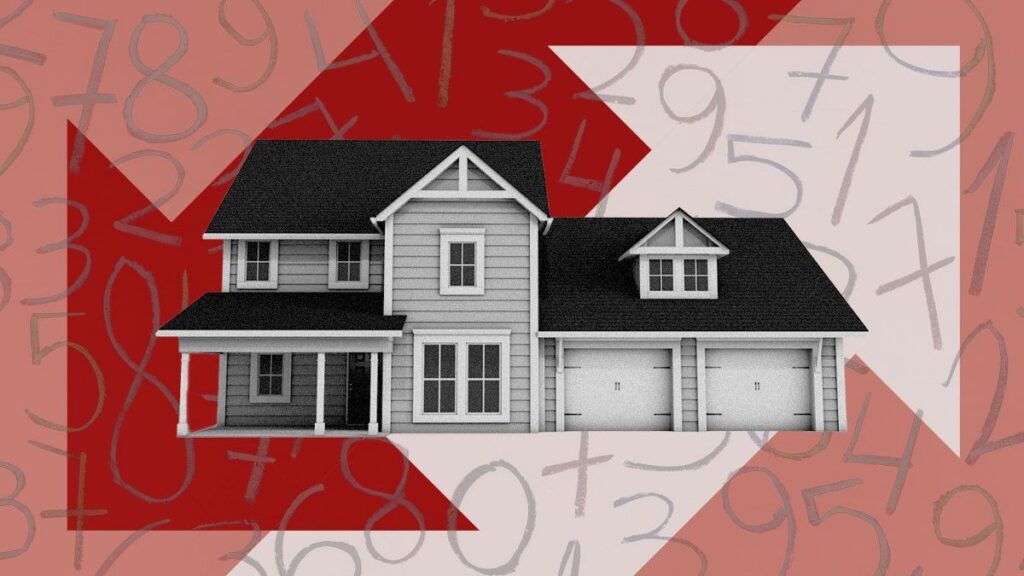
Photo-Illustration by Realtor.com; Source: Getty Images
These days, many folks are on edge over the much-feared housing recession—a dread that descended like a dark cloud last year as the real estate market seemed to seize up.
But it doesn’t appear that a housing bubble is about to pop. The housing market has slowed, to be sure, after mortgage interest rates rose rapidly in the back half of 2022 from rock-bottom lows below 3% to 20-year highs, briefly topping 7% before falling back into the 6% range. However, home prices are still going up in much of the country, while they’re falling in a few regions.
To clear the air and maybe quell the understandable impulse to clutch one’s pearls, we dug into what price changes around the country actually look like over the past year for the 250 biggest metropolitan areas in the U.S.—accounting for 85% of the national population—to see what the numbers say about home values.
Here’s what we found. For each metro, we tracked median home prices in March 2023, as well as year-over-year changes in overall price and price per square foot. Check out the market where you live!
In March, the median U.S. home listing was priced at $424,495, which is about 6% above where it was one year earlier, at $399,450 in March 2022. Looking at price per square foot (considered a more accurate metric for measuring price changes), the year-over-year increase is about 3%.
“Some people were predicting a bigger drop in prices,” says Realtor.com® Chief Economist Danielle Hale. “Our forecast was among the more optimistic. We expected a little more price stickiness, a little more resistance to falling prices, so I think for the general conversation about real estate, it might be a little surprising for people.”
There were about 15% fewer new listings in March 2023 than in March 2022. That reflected the pessimism in the housing market: Sellers are worried they won’t get the prices they want and are loath to give up the ultralow mortgage rates they secured during the COVID-19 pandemic when buying a new home.
To pull together our cross-country snapshot of where prices are up and down, we compared median home list prices in March to a year ago using publicly available data on Realtor.com. We found that prices dipped in only about 1 in 5 metros. (Metros include the main city and surrounding towns, suburbs, and smaller urban areas.)
!function(){“use strict”;window.addEventListener(“message”,(function(a){if(void 0!==a.data[“datawrapper-height”]){var e=document.querySelectorAll(“iframe”);for(var t in a.data[“datawrapper-height”])for(var r=0;r<e.length;r++)if(e[r].contentWindow===a.source){var i=a.data["datawrapper-height"][t]+"px";e[r].style.height=i}}}))}();
Across the U.S., but especially concentrated in the historically affordable Midwestern and Southern housing markets, homes are being listed above last year’s prices. In some cases, well above.
Take a place like Omaha, NE, where the median home listing price in March reached $344,500. That was up 80% from just one year ago when the median list price was just $190,000. There is also Davenport, IA, where median listing prices reached nearly $220,000 in March. That’s up more than 63% compared with one year before, when the median listing price was around $135,000.
Prices also rose dramatically in places like Jackson, TN, where they were up 59% year over year, to $223,000 in March; Champaign, IL, up 53%, to about $257,000; and Fayetteville, NC, up 44%, to $342,500.
“What we’re seeing is that real estate is becoming more regional and more local,” Hale says. “People have always said that, but for several years, housing was almost like a commodity, where everyone who owned saw appreciation. Now we see it really matters how the local economy is doing, how well the area is attracting new residents, how well the builders can keep up with demand.”
!function(){“use strict”;window.addEventListener(“message”,(function(a){if(void 0!==a.data[“datawrapper-height”]){var e=document.querySelectorAll(“iframe”);for(var t in a.data[“datawrapper-height”])for(var r=0;r<e.length;r++)if(e[r].contentWindow===a.source){var i=a.data["datawrapper-height"][t]+"px";e[r].style.height=i}}}))}();
But prices are down in historically more expensive areas of the country and places that attracted lots of new residents and saw skyrocketing demand during the pandemic-era real estate pump.
In Coeur d’Alene, ID, a popular vacation area that experienced a flood of new buyers over the past few years, the median list price was down 27% in March, to $717,000, down from $988,000 a year earlier. In Austin, TX, prices are down around 8%, to around $550,000. In Bend, OR, list prices fell about 6% below the same time last year, to $678,000, and in Denver, they’re down about 1%, to $655,000.
“There’s still room for prices to grow in the Midwest,” Hale says.
The post U.S. Home Prices Are Up, Down, and All Over the Place—See How They’re Faring Where You Live appeared first on Real Estate News & Insights | realtor.com®.
